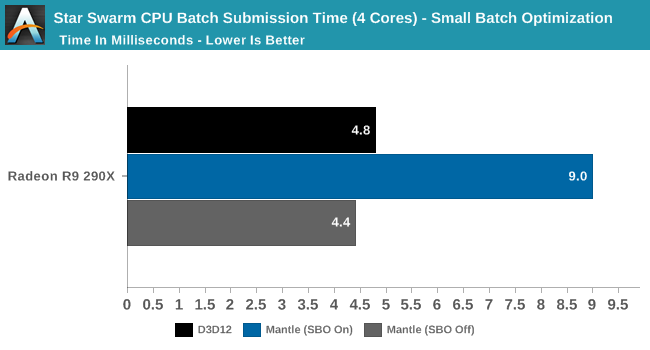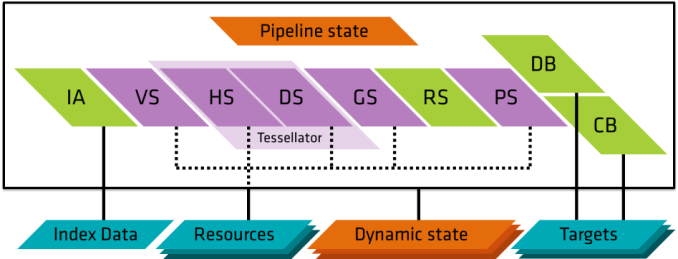AMD Lays Out Future of Mantle: Changing Direction In Face of DX12 and glNext
by Ryan Smith on March 2, 2015 10:45 PM EST
Much has been made over the advent of low-level graphics APIs over the last year, with APIs based on this concept having sprouted up on a number of platforms in a very short period of time. For game developers this has changed the API landscape dramatically in the last couple of years, and it’s no surprise that as a result API news has been centered on the annual Game Developers Conference. With the 2015 conference taking place this week, we’re going to hear a lot more about it in the run-up to the release of DirectX 12 and other APIs.
Kicking things off this week is AMD, who is going first with an update on Mantle, their in-house low-level API. The first announced of the low-level APIs and so far limited to AMD’s GCN’s architecture, there has been quite a bit of pondering over the future of the API in light of the more recent developments of DirectX 12 and glNext. AMD in turn is seeking to answer these questions first, before Microsoft and Khronos take the stage later this week for their own announcements.
In a news post on AMD’s gaming website, AMD has announced that due to the progress on DX12 and glNext, the company is changing direction on the API. The API will be sticking around, but AMD’s earlier plans have partially changed. As originally planned, AMD is transitioning Mantle application development from a closed beta to a (quasi) released product – via the release of a programming guide and API reference this month – however AMD’s broader plans to also release a Mantle SDK to allow full access, particularly allowing iit to be implemented on other hardware, has been shelved. In place of that AMD is refocusing Mantle on being a “graphics innovation platform” to develop new technologies.
As far as “Mantle 1.0” is concerned, AMD is acknowledging at this point that Mantle’s greatest benefits – reduced CPU usage due to low-level command buffer submission – is something that DX12 and glNext can do just as well, negating the need for Mantle in this context. For AMD this is still something of a win because it has led to Microsoft and Khronos implementing the core ideas of Mantle in the first place, but it also means that Mantle would be relegated to a third wheel. As a result AMD is shifting focus, and advising developers looking to tap Mantle for its draw call benefits (and other features also found in DX12/glNext) to just use those forthcoming APIs instead.

Mantle’s new focus in turn is going to be a testbed for future graphics API development. Along with releasing the specifications for “Mantle 1.0”, AMD will essentially keep the closed beta program open for the continued development of Mantle, building it in conjunction with a limited number of partners in a fashion similar to how Mantle has been developed so far.
Thie biggest change here is that any plans to make Mantle open have been put on hold for the moment with the cancelation of the Mantle SDK. With Mantle going back into development and made redundant by DX12/glNext, AMD has canned what was from the start the hardest to develop/least likely to occur API feature, keeping it proprietary (at least for now) for future development. Which is not to say that AMD has given up on their “open” ideals entirely though, as the company is promising to deliver more information on their long-term plans for the API on the 5th, including their future plans for openness.
As for what happens from here, we will have to see what AMD announces later this week. AMD’s announcement is essentially in two parts: today’s disclosure on the status of Mantle, and a further announcement on the 5th. It’s quite likely that AMD already has their future Mantle features in mind, and will want to discuss those after the DX12 and glNext disclosures.
Finally, from a consumer perspective Mantle won’t be going anywhere. Mantle remains in AMD’s drivers and Mantle applications continue to work, and for that matter there are still more Mantle enabled games to come (pretty much anything Frostbite, for a start). How many more games beyond 2015 though – basically anything post-DX12 – remains to be seen, as developers capable of targeting Mantle will almost certainly want to target DX12 as well as soon as it’s ready.
Update 03/03: To add some further context to AMD's announcement, we have the announcement of Vulkan (aka glNext). In short Mantle is being used as a building block for Vulkan, making Vulkan a derivative of Mantle. So although Mantle proper goes back under wraps at AMD, "Mantle 1.0" continues on in an evolved form as Vulkan.
Source: AMD











94 Comments
View All Comments
waltsmith - Monday, March 2, 2015 - link
I say kudos to AMD for forcing the issue on low-level API's. This is something that could, and should, have been done over a decade ago by microsoft(as the developer of the most widely used API). Pity it took a financially struggling, second fiddle manufacturer in both CPU and GPU markets to convince the software maker to do what needed to be done.Samus - Tuesday, March 3, 2015 - link
AMD has a history of doing this...don't forget AMD64?Without AMD pushing x86-64, Intel would still be trying to push IA64 and if 64-bit extensions were to be added to x86, it would have been years after AMD even introduced the idea.
Just one of many technologies Intel benefited from with their architecture licensing agreement with AMD, but by no means the chief.
CPUGPUGURU - Wednesday, March 4, 2015 - link
Intel didn't need a licensing agreement with AMD for 64 bit X86 Intel reverse engineered it. Quit making this crap up. Stop rewriting history and do your D&D and you won't look like a AMD pumping fool tool.elitewolverine - Wednesday, March 4, 2015 - link
Actually Intel did need to license the tech...gruffi - Wednesday, March 4, 2015 - link
You have no clue what you are talking about. Intel licensed AMD64 and renamed it to Intel64. Reverse engineered ... joke of the day.JonnyDough - Friday, March 6, 2015 - link
Correct. CPUGPUGURU is "some guru". Not!WinterCharm - Thursday, March 5, 2015 - link
For a so called guru, you're surprisingly ignorant.MamiyaOtaru - Friday, March 6, 2015 - link
I'm leaning towards this being a troll. The juxtaposition of username and ignorance of the subject is just to incredible otherwiseJonnyDough - Friday, March 6, 2015 - link
Troll much?CPUGPUGURU - Friday, March 6, 2015 - link
You delusional AMD pump boys are a bunch of fact-less fool tools who can't read to learn and spew BS out of your orifice like bull with diarrhea. You're too lame brained to be educated and instead of reading the facts you blatantly post fiction you pulled out from your AMD pumping stink hole.I REPEAT INTEL REVERSE ENGINEERED X86 64 bit and DOES NOT License AMD's version!
READ LEARN and STFU!
Intel Did Not license the x86 64 bit from AMD, Intel instead Reverse Engineered x86 64 bit, read, "Microprocessor Reports", the article, "AMD and Intel Harmonize on 64" can be found in the March 29th edition of In-Stat/MDR's Microprocessor Report
"Intel's reverse-engineering of AMD64 " says Halfhill. "
Intel Did Not license the x86 64 bit from AMD, Intel instead Reverse Engineered x86 64 bit, read, "Microprocessor Reports", the article, "AMD and Intel Harmonize on 64" can be found in the March 29th edition of In-Stat/MDR's Microprocessor Report
"Intel's reverse-engineering of AMD64 " says Halfhill. "
You're welcome